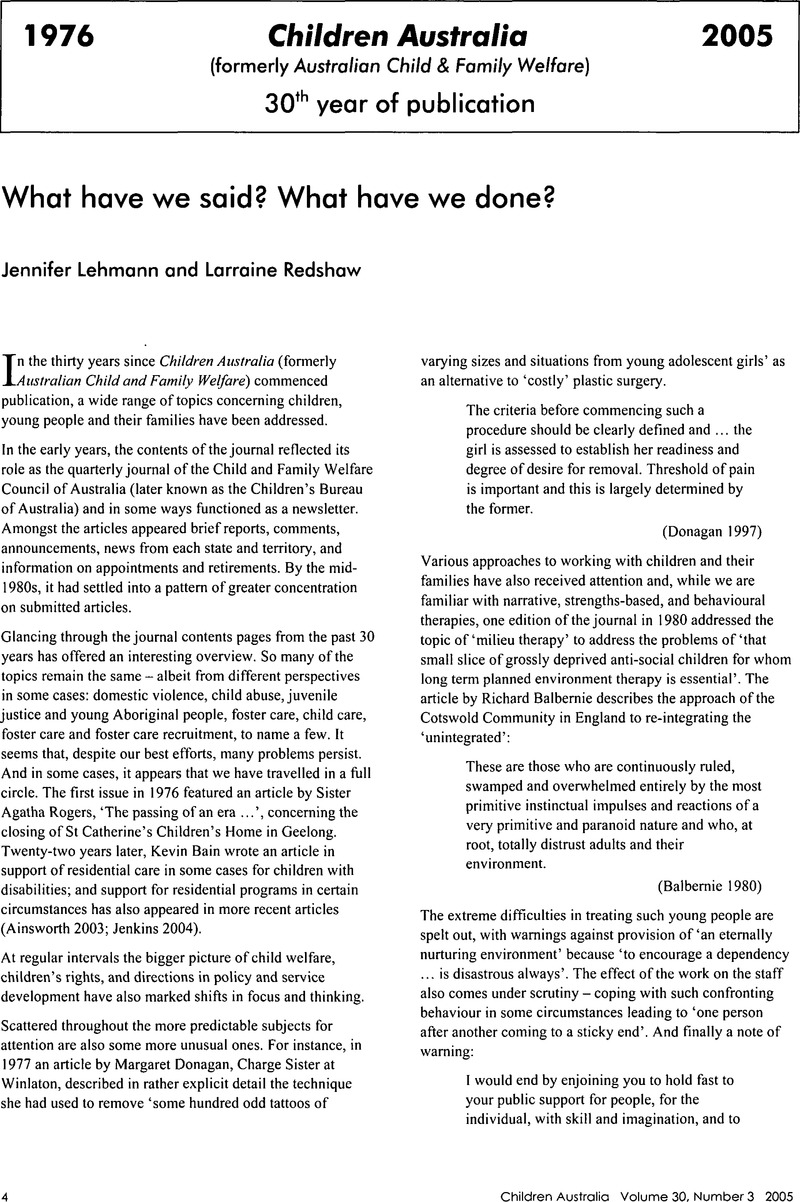No CrossRef data available.
Article contents
What have we said? What have we done?
Published online by Cambridge University Press: 29 February 2016
Abstract
An abstract is not available for this content so a preview has been provided. Please use the Get access link above for information on how to access this content.

- Type
- Children Australia (formerly Australian Child & Family Welfare): 30th year of publication
- Information
- Copyright
- Copyright © Cambridge University Press 2005
References
Ainsworth, F. (2003) ‘Unfounded assumptions and the abandonment of ‘at risk’ youth’, Children Australia, Vol 28, No 1, pp.24–28.Google Scholar
Bain, K. (1998) ‘The long term care of children with disabilities: Is family the only way?’ Children Australia, Vol 23, No 3, pp.9–16.Google Scholar
Balbernie, R. (1980) ‘Milieu therapy and the unintegrated’, Australian Child & Family Welfare, Vol 5, Nos 1 & 2, pp.22–28.Google Scholar
Cashmore, J. & O’Brien, A. (2001) ‘Facilitating participation of children and young people in care’, Children Australia, Vol 26, No 4, pp. 10–15.Google Scholar
Challinger, D. (1982) ‘Prisoner-mothers’, Australian Child & Family Welfare, Vol 7, No 2, pp.24–29.Google Scholar
Daly, W., McPherson, C. & Reck, L. (2004) ‘SPLAT: A model of young people’s participation that moves beyond the rhetoric to empowerment’, Children Australia, Vol 29, No 4, pp.20–26.Google Scholar
Donagan, M. (1977) ‘Removing tattoos: A technique’, Australian Child & Family Welfare, Vol 2, No 1, p. 14.Google Scholar
Fleming, J. (2004) ‘The importance of fathers in building stronger families’, Children Australia, Vol 29, No 2, pp.30–34.Google Scholar
Healy, K., Foley, D. & Walsh, K. (2001) ‘Families affected by the imprisonment of a parent’, Children Australia, Vol 26, No 1, pp. 12–19.Google Scholar
Jenkins, S. (2004) ‘Developing a residential programme for children in response to trauma-related behaviours’, Children Australia, Vol 29, No 3, pp.22–29.Google Scholar
Killeen, D. with Lehmann, J. (2004) ‘Non-residential fathers and their support needs’, Children Australia, Vol 29, No 5, pp. 12–19.Google Scholar
King, A. (2005) ‘The “quiet revoluation” amongst men: Developing the practice of working with men in family relationships’, Children Australia, Vol 30, No 2, pp.33–37.Google Scholar
Kiraly, M. (2001) ‘Give everyone a say: The involvement of young people in selecting program staff’, Children Australia, Vol 26, No 1, pp.20–26.Google Scholar
Mason, J. & Falloon, J. (1999) ‘A children’s perspective on child abuse’, Children Australia, Vol 24, No 3, pp.9–13.Google Scholar
Mason, J. & Urquhart, R. (2001) ‘Developing a model for participation by children in research on decision making’, Children Australia, Vol 26, No 4, pp. 16–21.Google Scholar
Mudaly, N. & Goddard, C. (2001) ‘Listening to the child victim of abuse through the process of therapy: A case study’, Children Australia, Vol 26, No 3, pp. 18–22.Google Scholar
Owen, L. (1985) ‘Some observations on the themes of International Youth Year 1985. Part 1’, Australian Child & Family Welfare, Vol 10, No 3, pp. 13–18.Google Scholar
Palmer, D. (1981) ‘Behind every good soldier …’, Australian Child & Family Welfare, Vol 6, No 1, pp. 14–17.Google Scholar
Paull, T. (2004) ‘Why don’t fathers attend parent education programs?’ Children Australia, Vol 29, No 1, pp.12–18.Google Scholar
Picton, J. (1989) ‘Gardens and personal growth’, Australian Child & Family Welfare, Vol 14, No 3, pp.14–15.Google Scholar
Reimer, E. (2003) ‘A scaffold for participation in agency work’, Children Australia, Vol 28, No 3, pp.30–37.Google Scholar
Rigby, K. & Bagshaw, D. (2001) ‘What hurts? The reported consequences of negative interactions with peers among Australian adolescent school children’, Children Australia, Vol 26, No 4, pp.36–41.CrossRefGoogle Scholar
Rigby, K. (1997) ‘What children tell us about bullying in schools’, Children Australia, Vol 22, No 2, pp.28–34.Google Scholar
Rogers, M.A. (1976) ‘The passing of an era …’, Australian Child & Family Welfare, Vol 1, No 1, pp.6–8.Google Scholar
Slee, P.T. & Cross, D.G. (1988) ‘Children’s and adolescents’ fears and the threat of nuclear war: An Australian study’, Australian Child & Family Welfare, Vol 13, No 1, pp. 15–17.Google Scholar
Wraith, R. & Gordon, R. (1987a) ‘The response to disaster of individuals and families within their community’, Australian Child & Family Welfare, Vol 12, No 3, pp.2–10.Google Scholar
Wraith, R. & Gordon, R. (1987b) ‘The myths of response to disaster by people and communities’, Australian Child & Family Welfare, Vol 12, No 3, pp.26–28.Google Scholar


